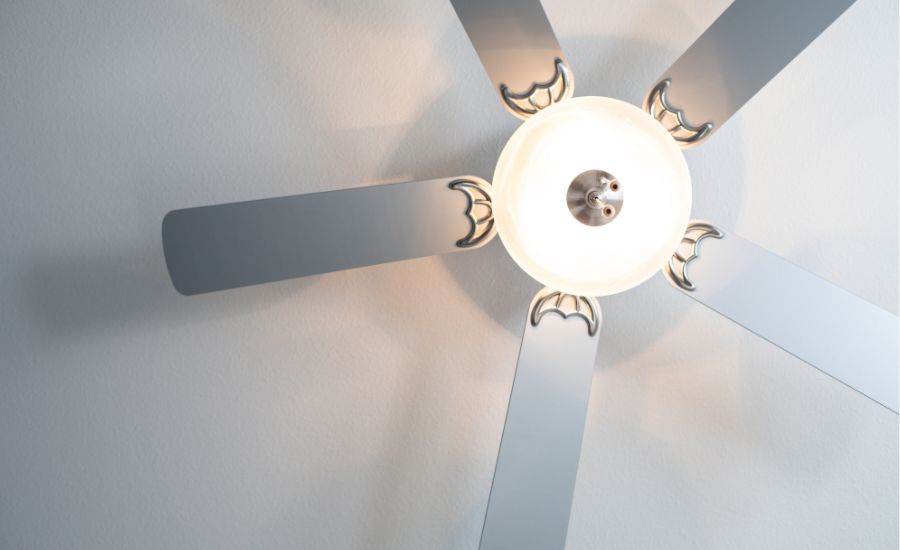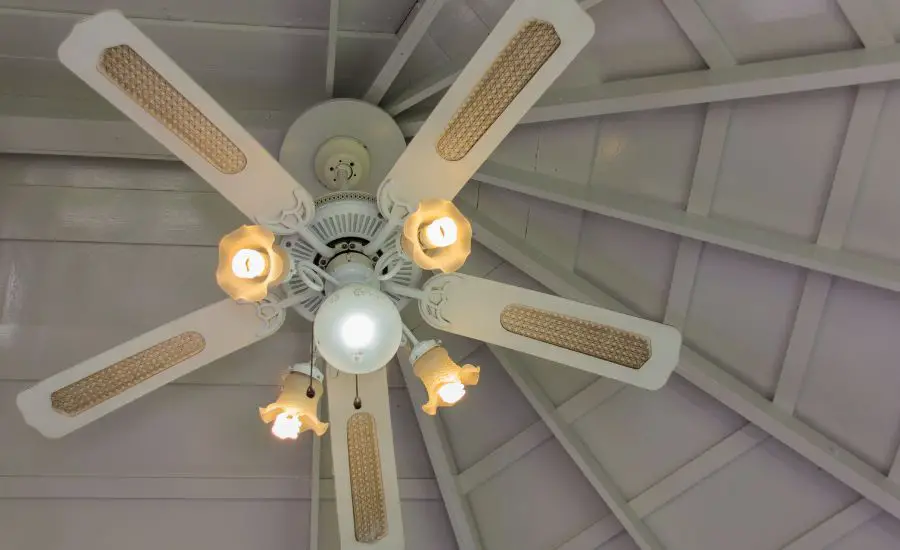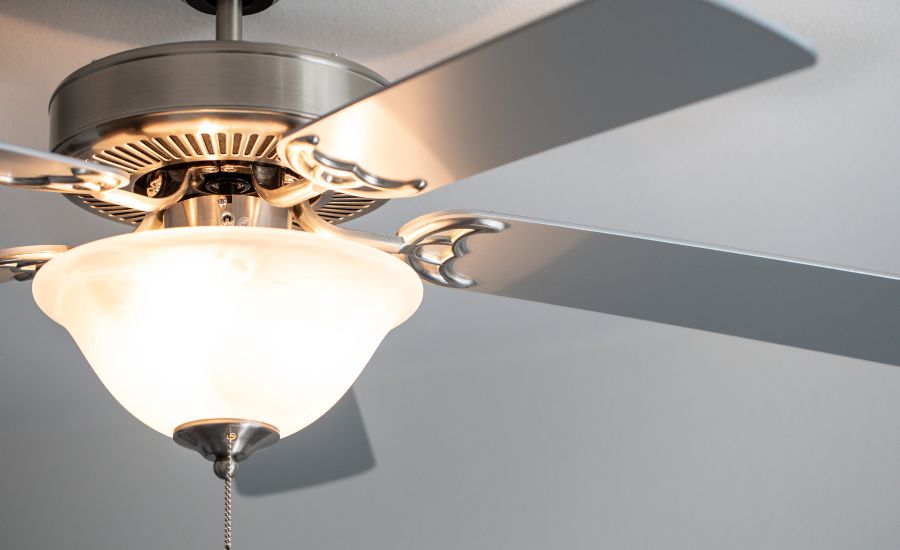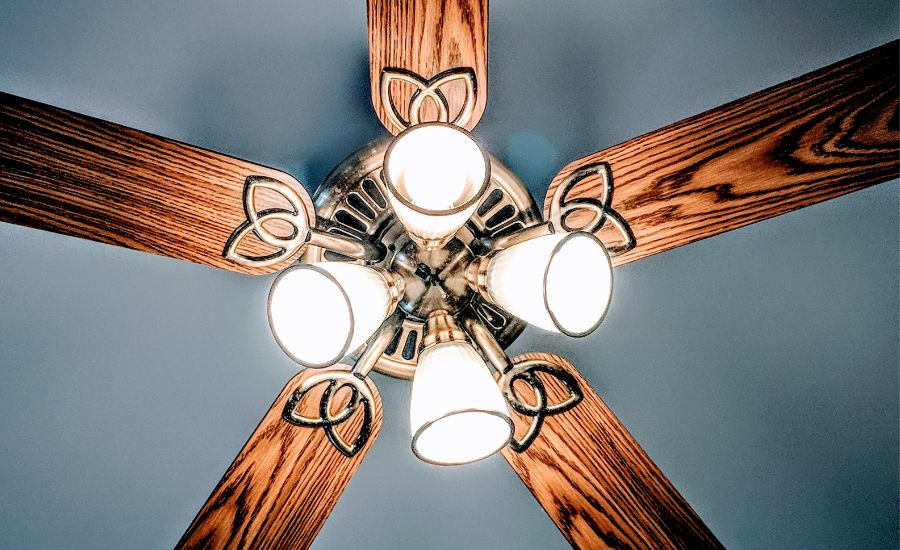Ceiling fan lights are essential because they offer both functional and decorative lighting, however, with time, you could find that the ceiling fan light, which was once beautifully illuminating, has lost some of its radiance and has made your room darker than usual.
Why does this happen and how can you fix it? Everything you need to know about ceiling fan lights will be carefully explained in this article as we explore “How to make ceiling fan light brighter”.

Why does your ceiling fan light get dimmer?
Your ceiling fan light being deemed is likely because it was set that way, most ceiling fans come with a remote control which you can use to control the speed and the light brightness.
However in many situations, this might not be the case, there are several other reasons why your once bright ceiling fan light becomes dimmer and isn’t as bright as it used to be, these reasons include LED lights heat buildup, dirt, and dust, LED lights aging and electrical wiring issues, the above-listed issues and more will be examined in detail below.

Reasons why your fan light gets dimmer
The situations that can lead to your ceiling fan light getting dimmer are carefully examined below to give you a better understanding of the issue.
Dirt and dust
Ceiling fan lights are exposed to the air in your living spaces, and over time, they can accumulate a layer of dirt and dust, this accumulation may go unnoticed at first, but as it continues, its effects become clear.
The surfaces of the light bulb and fixture collect dust particles, which act as a barrier between the light source and the space, as a result, the brilliance of the light is decreased since it is diffused and occluded.
A reduction in the amount of light that can flow through is the main effect of dirt accumulation, your ceiling fan light may appear dimmer than it did when it was clean due to this reduction in light output.
Bulb aging
Although ceiling fan bulbs are made to offer dependable lighting, aging still influences them, dimmer illumination may result as light bulbs steadily decrease in performance with time.
Light bulbs, whether incandescent, CFL, or LED, all have a finite lifespan, with time the materials within the bulb deteriorate, causing a decrease in their ability to emit light effectively, and the brightness of the bulb is reduced with bulb aging, as the bulb’s components deteriorate, the light it emits gets progressively dimmer.
Heat buildup
A ceiling fan light bulb produces heat when it is in use, even though modern designs have heat-dissipating features, extended use or poor ventilation can cause heat to build up, and the performance of the light bulb and its surrounding components might be impacted by excessive heat, which can ultimately affect brightness.
The filament or LED components of a light bulb may function at higher temperatures than recommended as a result of heat buildup, this may result in less light being produced and a dimmer appearance of the ceiling fan light.

Voltage fluctuations
Another possible cause of dimming in the light fixture of ceiling fans is voltage changes, the performance of the light bulb may be impacted by these variations in the electrical supply, resulting in uneven brightness.
Variations in the electrical voltage supplied to your home are known as voltage fluctuations.
Other appliances in use, changes in grid load, and external factors are examples of the possible factors that might cause these fluctuations, voltage drops reduce the amount of electricity that reaches the lightbulb, the light may dim or flicker as a result, which will reduce its brightness and stability.
Power source issues
A ceiling fan light fixture relies on a stable and consistent power supply to function normally, power source issues can arise from various factors, including electrical surges, inadequate electrical wiring, and shared circuits.
The quantity of electricity reaching the light bulb may also decrease due to a lack of power supply or voltage fluctuations, the light may dim or flicker as a result of this, and the brightness and stability of the ceiling fan light fixture may also change as a result of fluctuations in the power supply.
Electrical wiring issues
Dimming of the light may also result from loose electrical wiring in ceiling fans, a light’s brightness, and stability can be impacted by electrical wiring issues, which can also obstruct the appropriate flow of electricity.
Ceiling fans are complex electrical systems with many parts, including electrical wiring that links the fan, light, and power supply, electrical wiring or wires may become loose or detached over time as a result of vibrations, motions, or poor installation.
Bad electrical wiring poses a safety hazard, as it can lead to overheating, short circuits, or even electrical fires, addressing electrical wiring issues promptly is crucial to prevent accidents, loose electrical wiring can cause the ceiling fan light to work inconsistently, turning on and off unexpectedly or responding erratically to controls.

5 effective solutions
Now that the causes and reasons why your ceiling fan light can become less brighter has be explained, let’s examine effective approaches to make ceiling fan light brighter.
Replace bulbs and Upgrade the light kit
Choosing the proper bulbs is the first step toward a brighter ceiling fan light, choose a brighter bulb or consider going for recommended LED light bulbs and a color temperature that blends in with the atmosphere of your space to make the light brighter, LED bulbs are particularly popular for their energy efficiency and powerful lighting.
Upgrade kits come in a variety of styles and finishes, allowing you to match the kit to your ceiling fan’s design or your room’s decoration to ensure a cool and pleasing look.
Before changing out LED bulbs or working on any electrical parts, always turn off the ceiling fan light using the light switch or remote control, this guarantees your safety when installing the LED light bulb or when making any electrical adjustment.
When changing bulbs, carefully unscrew the existing bulbs in a counterclockwise direction, if you’re using an upgrade kit, remove the old light kit according to the manufacturer’s directions.
Carefully screw in the new LED bulbs clockwise, ensure they are securely fitted but avoid overtightening, if you’re installing an upgrade light kit, carefully follow the manufacturer’s instructions, this usually involves connecting electrical wiring, mounting the new light kit, and securing it properly, once you’ve completed the installation, turn the power back on and test the new light bulb or upgrade kit.
Choose higher wattage
The wattage of a light bulb describes how much energy it uses, in the past, brighter lamps were typically associated with higher power bulbs, but as energy-saving technology like LED light bulbs have emerged, the connection between wattage and brightness has grown increasingly complex.
A higher-wattage light bulb certainly has a tendency to create more light, but when choosing a light bulb, it’s important to take into account things like LED bulb type and the lumen output, if you’re seeking a straightforward solution to address dim LED lights, switching to higher wattage bulbs is an effective solution.
You should also consider removing the wattage limiter if your fan has one, this wattage limiter reduces the light supply and lumen output preventing bright lights

Clean the light fixture
Dim LED lights or LED bulbs are frequently caused by dirt and dust accumulation, the light emitted is diffused and obstructed as a result of these particles settling to the surfaces of the light bulb and light fixture over time, reduced brightness, uneven lighting, and an unappealing appearance may result from this.
You can bring your ceiling fan light back to its normal brightness and make your ceiling fan light brighter by clearing away any accumulated dust, this instantly restores the lighting in the space and results in brighter light from your ceiling fan light.
Use a soft, dry cloth or a duster to gently wipe the inside and outside surfaces of the LED light fixture of the ceiling fan, pay attention to electrical wiring or corners in the light fixture that might trap dust.
You have successfully made your ceiling fan light brighter, ensure all parts are completely dry before reassembling the light fixture.
Install additional lighting
Sometimes a room might require more than one source of light to achieve optimal brightness, in such cases, installing additional lighting near the ceiling fan can provide the extra brightness needed, additional lighting allows you to tailor the room’s brightness to your specific preferences and needs.
Recessed lighting, table lamps, blue light lamps, and pendant led lights can be beautiful accents that go well with your ceiling fan to improve the general appearance of the room.
Using light diffusers
When light rays strike an object or surface, they scatter and spread out in different directions, this is known as light diffusion.
Light diffusers spread the light emitted by your ceiling fan bulb more evenly across the room, this reduces concentrated spots of light and effectively enhances the brightness of the entire space.
Choose diffusers that are compatible with your ceiling fan model and LED bulb type, some ceiling fans are designed to accommodate specific types of diffusers, so ensure a proper fit to your ceiling fan.

FAQ
Your ceiling fan light not being bright enough can be due to tons of reasons including an old bulb or electrical wiring issues or simple dirt and dust issues, first try to solve these problems with a LED light bulb.
Your dim Hunter fan is most likely due to a bulb compatibility issue, ensure the bulb in the Hunter fan is compatible with the fan.
Various lights are regarded by different people as “the best”, these lights include LED, CFL, and halogen lights.
Conclusion
Your living environment is a reflection of your lifestyle, and the lighting within it plays a significant role in setting the tone, understanding the potential causes of dimmer lights, and using this article as a guide you can easily make your ceiling fan light brighter and enjoy a bright environment.

Here, I provide valuable insights into the lighting industry, drawing from 12 years of experience. My aim is to share useful and practical tips, life hacks, and comprehensive product reviews. I hope that collective expertise, advice, and recommendations prove beneficial to you.



